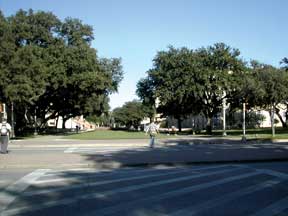|
Putting down (new) roots
By Allison Speer '91
It's safe to say that most Horned Frog alumni today walk down a tree-lined memory lane when conjuring up their college years. And though Texas is not typically known for its lush vegetation, you wouldn't know it when driving down University or strolling along the sidewalks. Even on a hot July day, the sun has trouble reaching the concrete through the expansive shade provided by protective sycamores and live oaks. But it hasn't always been that way.
TCU's transformation from prairie to pretty began in 1913, when local businessman W.C. Stripling (of Stripling's Department Store fame) donated 100 trees to the campus. In addition, F. T. Ramsey of the Austin Nursery provided a large part of the campus' original greenery.
Then just before Arbor Day in 1915, a professor asked nearly every student and faculty member to furnish a tree. Leave it to Horned Frogs to be loyal and dedicated; almost 400 trees were planted in a special ceremony. Although some 50 live oaks were killed by winter freezes (and the occasional car crash) in the early '30s, they were quickly replaced and many of those original trees stand today.
Recently some 31 live oaks that lined the circular drive in the center of campus - one percent of all trees on campus - were felled to make way for a new kind of growth at TCU: the Campus Commons. With the exception of five trunks that were cured to use for plaques and picture frames, all of the wood was mulched and recycled.
Soon, new residence halls will grow where those trees once thrived. After standing strong for so many years, those giants forfeited their space so that the next crop of students can have an equally beautiful place to live and learn.
Comment at
tcumagazine@tcu.edu


|



